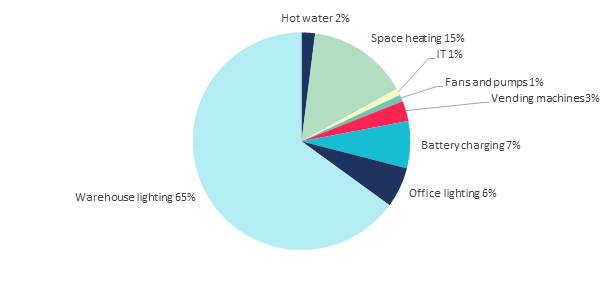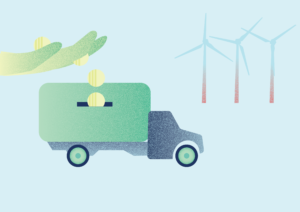What do diesel, electricity and a cheese sandwich have in common? They all power the distribution and logistics sector. They keep trucks, robots, refrigerators, and hardworking employees running.
In the distribution and logistics sector, energy is probably the single most critical ingredient.
That also means energy makes up a huge part of the yearly bill. And therefore, energy savings provide a good return on investment. Which is great for your bank account, but also for our planet. We’ll tell you how to do this. And how to cooperate on this as a tenant, building user, landlord and/or asset manager.
We’ll specifically talk about distributions centers and warehouses here. Warehousing costs accounts for almost 10% of company’s revenue, with heating and lighting as the two largest energy consumers. Before we dive into concrete tips, let’s first discuss how split incentives in buildings make energy savings difficult.
Split incentives between stakeholders
If your warehouse or distribution center is owner-occupied, investments are your responsibility, but also the returns land with you. So many of the energy savings tips we will provide later, are no-brainers.
But if you’re a building user, tenant, landlord or an asset manager, the incentives are skewed: the one making the effort or the investment is not the one receiving the returns. We’ll introduce some energy saving tips per stakeholder, and lastly, discuss how you can all cooperate on energy saving.
Building user (or employee)
If you work in a distribution center or warehouse, unless you own shares, your energy saving efforts will not result in a monetary reward. Still, saving money for your employer and making the world just a little greener, remain important motivators. What you can do:
1. On cold days, wear warm cloths. You don’t have to warm up the entire space: just warm up yourself. This way, warehouses can operate almost year-round without heating. Is your labor physical, then temperatures of a minimum of 13 degrees Celsius are fine. Otherwise, a minimum of 16 degrees applies. You can also ask your employer to provide you with proper clothes so that the heating can be turned down.
2. Be proactive: switch off heating and lighting during the nights and weekends.
3. Show some love to your tools. Well maintained equipment not only has a longer lifespan, but also lowers friction in your machines which can reduce energy loss up to 40%.
Machine design changes, new materials and efficient lubricants could reduce energy losses by 18–40%, mainly resulting from friction and wear. The savings would be up to 8.7% of the total global energy use.
Tenant
The energy bill is yours to pay. So, for you, it makes most sense to actually understand what’s on there. The average energy use of a distribution company, looks as follows:

Some of the tips we’ll introduce below, you can implement today. For others, you might want to cooperate with your landlord or the asset manager.
4. You can also place timers or sensors so that machines, lighting and heating automatically switching off, or remind staff to switch off machines, lights and heating for the night and weekend. Did you already know about daylight sensors? When enough natural light flows into a space, these make sure that your artificial lighting is turned low or off.
5. Understand your energy usage and make all employees aware of it too. For example, by using the energy engagement software of hello energy (yes, we’re advertising a little bit for ourselves here). You can also use power monitoring devices to measure, track and visualize energy use throughout your facility real-time. Analyze the data well to make it meaningful and actionable.
6. When cranes and lifts (often used in automated warehouses) break or move down, energy is released. This energy can be captured, just as a car battery loads when breaking of driving downhill. Because the downward motion in warehouses is often done with more weight than the upward motion, an energy saving of 20% can be realized.
7. Reduce conveyor speed during low-throughput periods.
Building owner (landlord or asset manager)
The difficulty of energy saving for landlord and asset managers, is that the fruits of your investments are reaped by the tenant. Luckily, we have some solutions for that. First, let’s see what you can do to make your buildings more energy efficient.
8. Switch from inefficient lighting to 150W LED. This can reduce the electricity use (and your tenant’s bill) by 70 percent! Small investment, huge result.
9. Due to the size of distribution centers and warehouses (and their roofs), solar panels are often a great idea. With current electricity prices going through the roof (pun intended), and solar panels being pretty efficient, the payback period has hugely shortened. You could have your tenant pay per kwh for the energy you provide, so you earn back your investment.
10. Whereas warehouses can often do without heating, offices, canteens, toilets and other small rooms need to be heated. Insulation greatly helps. If you’re renovating or extending your warehouse space, this is a good moment to improve insulation. Especially focus on the most common places of heat loss (see figure below).
11. As you can see in the chart below, it probably pays off if you check your warehouse for air leakage. Walk around with a laser gun on a cold day to easily spot these leakages. It’s actually pretty fun to do too.
12. Install integrated energy management controls. When renewable energy makes up increasingly large shares, predicting supply and demand becomes more important. Energy management controls help you optimize the allocation of available energy budgets to different processes. For example, when supply is low, it will delay the automated pick-up of a number of orders for a few seconds, in order to avoid peak demand.

All together
As mentioned earlier, when it comes to saving energy, there are split incentives between building user, tenant, landlord and asset manager. To overcome this barrier, engage in conversation with each other in order to find common motivators. You all want a brighter future for next generations, right?
There are also ways to more evenly distribute monetary costs and benefits. Look into green leases together, have your tenants pay per unit of energy used from the solar panels you installed or share the energy expenses saved after installing better insulation.
Also, engage in energy management together. With the insights of hello energy into a building’s energy use, this becomes much easier. This is step one into resolving barriers that split incentives pose to sustainability programs or energy efficiency programs.
Hope this helps. Let’s beat the bill!
